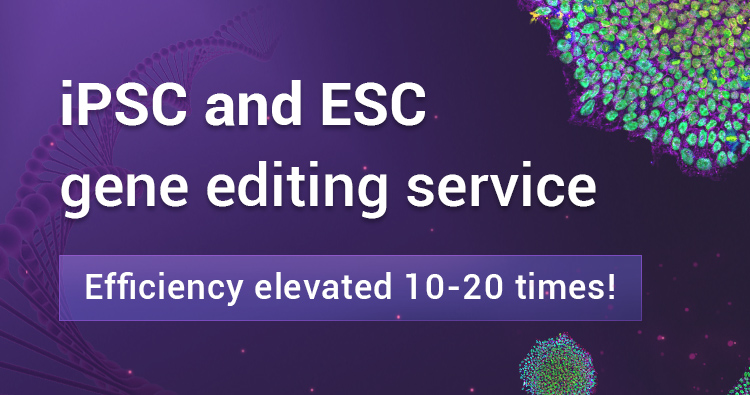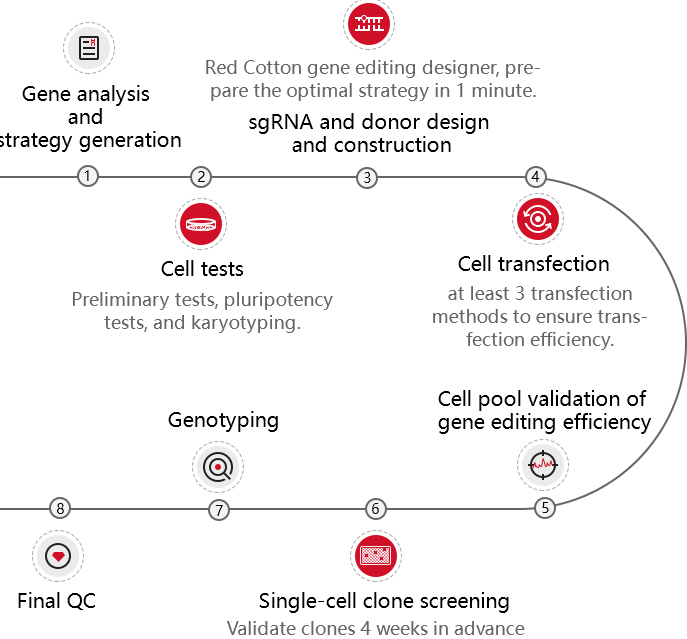

Location: Home > Gene Editing Services > Stable Cell Lines > iPSC and ESC gene editing service


Embryonic stem cells (ESC) and induced pluripotent stem cells (iPSC) have pluripotency and can theoretically differentiate into all organs, tissues or cells. As early as the 1980s, mouse ESC has been applied to gene-recombination modification for gene function research. Specifically, it refers to transfecting the homologous targeting vector carrying modified gene into mouse ESCs, injecting the positive clones into blastocysts, and then transplanting them into surrogate mice to obtain chimeric mice. Human ESC is mainly applied in disease model construction. With the appearance of iPSC technology in 2006 and the development of more than ten years, iPSC has gradually replaced ESC in some researches.
At present, iPSC and ESC in the research of gene function, disease model, or drug screening usually needs to be combined with gene editing technology. CRISPR/Cas9, as the most mainstream gene editing technology in recent years, has the advantages of high efficiency, simple and low cost. It has been widely used in stem cells gene knockout, point mutation and knockin.
>>>Learn More: CRISPR Gene Edited ESCs/iPSCs for Regenerative and Personalized Medicine
 Knockout
Knockout  Point mutation
Point mutation  Knockin
Knockin As a global company focusing on CRISPR gene editing technology in cell lines, Ubigene has comprehensively optimized the whole technical process of iPSC gene editing and successfully provided over 300 gene-edited iPSC/ESC to more than 40 countries and regions in the world.
| Cell type | iPS, H1, H9, etc. |
| Service | Gene knockout, point mutation, knockin |
| Turnaround | As fast as 12 weeks |
| Deliverable | positive clone |
| Price | Start from $8680 |


At present, there are many cases of CRISPR gene editing applied in iPSC for disease model construction, such as neurodegenerative diseases, metabolic diseases and cardiac genetic diseases. The following table summarizes some relevant studies in previous years.
| Gene editing type | Disease | Gene | Disease model | Cell therapy |
| CRISPR-KO disease modeling | Immunodeficiency, centromeric instability, and facial abnormalities (ICF) syndrome | DNMT3B | √ | |
| Dominant dystrophic epidermolysis bullosa(DDEB) | COL7A1 | √ | ||
| Tangier disease (TD) | ABCA1 | √ | ||
| Atrial fibrillation (AF) | KCNA5 | √ | ||
| CRISPR-KO regain normal function | Fragile X syndrome (FXS) | FMR1 | √ | |
| Duchenne muscular dystrophy (DMD) | dystrophin | √ | √ | |
| CRISPR-KI mutation repair | Myositis ossificans progressiva (MOP) | ALK-2 | √ | |
| Chronic granulomatous disease (CGD) | CYBB | √ | √ | |
| Amyotrophic lateral sclerosis (ALS) | SOD1 and FUS | √ | ||
| Frontotemporal dementia | CHMP2B | √ | ||
| Abetalipoproteinemia | MTTP | √ | ||
| Hypertrophic cardiomyopathy (HCM) | PRKAG2 | √ | ||
| CRISPR combined with piggyBAC | Beta-thalassemia | HBB | √ | √ |
| Brugada syndrome | SCN5A | √ | ||
| Huntington's disease(HD) | HTT | √ | ||
| Hereditary motor sensory neuropathy (HMSN) | TFG | √ | ||
| Tetrahydrobiopterin (BH4) deficiency | PTPS and DHPR | √ | ||
| HIV | CCR5 | √ | √ | |
| Polycythemia vera (PV), α 1-antitrypsin (AA T) deficiency | JAK2-V617F and SERPINA1 | √ | ||
| CRISPRi gene knockdown | Long QT syndrome(LQTS) | CALM2 | √ |
Autosomal dominant polycystic kidney disease (ADPKD) is the most common hereditary kidney disease, with an incidence rate of about one in 400-1000 people. About half of patients with this disease will develop end-stage renal disease, requiring dialysis or kidney transplantation. ADPKD is associated with two gene defects, of which 85% are caused by mutations in the gene PKD1 (trpp1) located on chromosome 16. Romano et al. generated isogenic iPSC with heterozygous knockout and homozygous knockout in PKD1 gene by using CRISPR/Cas9 technology. And verified that iPSC maintained stem cell like morphology, normal karyotype, pluripotency and differentiation ability in three germ layers. It can be used as a model for studying the pathogenesis of ADPKD and drug screening.

β-Thalassemia is a monogenic disease caused by point mutation or fragment deletion of the HBB gene leading to loss of normal β-globin peptide chain or insufficient synthesis of β-globin. The prevalence of β- thalassemia carriers in southern China is 2.54%, which has been threatening the lives of millions of people for decades. At present, hematopoietic stem cell transplantation is the only available radical treatment for patients with severe β-thalassemia. However, hematopoietic stem cell transplantation is limited by the lack of HLA-matched healthy donors in most patients. With the wide application of gene editing technology, researchers used CRISPR/Cas9 system to perform gene editing on patient-derived iPSCs (genotype: homozygous 41/42 deletion), mainly designed gRNA targeting HBB mutation position, and recombined PCR products containing normal sequences (WT) as donor templates, and then screen cells with mutation repaired genotype. The successfully corrected iPSCs were re-differentiated into hematopoietic stem cells (HSCs), and then the HSCs were transplanted to the irradiated NSI immunodeficient mice. Finally, it was found that the mice transplanted with the corrected iPSCs could have normal hematopoiesis and produce normal HBB protein. This study brings new hope for the treatment of β-thalassemia.

Chemokine receptor 5 (CCR5), as a co-receptor of HIV virus, is essential for the cellular infection of CCR5 tropic virus. Studies have shown that the loss of CCR5 function can prevent HIV infection. Through gene editing of immune cells in patients, it is possible to treat HIV. However, due to the low transfection efficiency of immune cells and the difficulty of cell culture, it is difficult to directly gene edit these cells. Kang et al. performed gene editing on iPSC by using CRISPR/Cas9 technology, designed a single gRNA knockout strategy and a double gRNA knockout strategy targeting CCR5, and successfully screened the CCR5 knockout homozygous clones. iPSCs with homozygous CCR5 mutations still show the typical characteristics of pluripotent stem cells and effectively differentiate into hematopoietic cells and macrophages. In vitro HIV infection experiment showed that the KO cells had unique resistance to the attack of CCR5 tropic virus. This study shows that combining iPSC technology with CRISPR/Cas9 technology has a promising application in the treatment of HIV infection.

